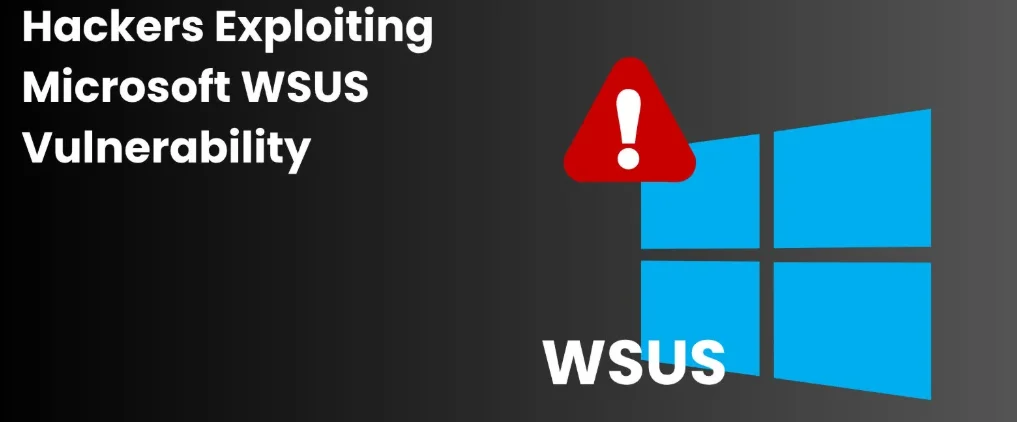Security teams have been alerted that a critical flaw in Microsoft’s WSUS product (used for patch management in many enterprises) is being actively exploited in the wild. This isn’t just a vulnerability to patch — it highlights broader risk in patch-management infrastructure and the need for heightened vigilance.
What’s the Vulnerability?
- The flaw is tracked as CVE‑2025‑59287, a deserialization-of-untrusted-data vulnerability within the WSUS service.
- The severity is rated 9.8 out of 10 (CVSS v3) — indicating a critical risk.
- Attackers with no privileges and no user interaction can execute arbitrary code with SYSTEM level privileges on impacted servers.
- The affected product versions include WSUS on Windows Server 2012, 2016, 2019, 2022 and the newly released Server 2025.
Why It’s Especially Dangerous for Enterprises
- Patch-management infrastructure compromise – WSUS is often the service that delivers updates across large corporate networks. If that is compromised, an attacker can pivot, mount supply-chain style attacks, or spread widely.
- Low complexity exploit – Because no authentication or user interaction is required and attacker privileges begin at null, the time to compromise can be extremely short.
- Active exploitation – Proof-of-concept (PoC) code is already public and exploit activity has been observed in the wild.
Key Facts and Statistics
| Metric | Value | Notes |
|---|---|---|
| CVE severity (CVSSv3) | 9.8/10 | Extreme criticality. nuharborsecurity.com |
| Approx. exposed WSUS instances found | ~2,500 worldwide | Eye Security reported ~2,500 vulnerable WSUS servers. SecurityWeek |
| Known exploited in wild | Yes | Confirmed by multiple national CERTs and by Cybersecurity and Infrastructure Security Agency (CISA) alert. Cyber Security News |
| Affected Windows Server versions | 2012, 2016, 2019, 2022, 2025 | Broad range of server versions. SecurityWeek |
Impact on Enterprise Risk Profile
- Operational disruption risk: Because WSUS controls patch distribution, a compromised server can lead to large-scale update failures, delays, or malicious updates.
- Lateral movement & supply-chain risk: If attackers gain SYSTEM privileges on WSUS, they can distribute malicious payloads or move across internal networks.
- Regulatory & compliance risk: Enterprises that fail to mitigate known critical vulnerabilities may face regulatory scrutiny, especially with eyes on supply-chain integrity.
- Financial risk: The cost of remediation, downtime, and breach response for a compromised trusted infrastructure component is significantly higher than a traditional end-user exploit.
Recommended Immediate Actions for Enterprises
- Apply the out-of-band Microsoft patch immediately for CVE-2025-59287. Microsoft released an emergency update.
- Isolate WSUS servers: If patching is delayed, restrict inbound access to ports 8530/TCP and 8531/TCP (used by WSUS) at the firewall level.
- Review your WSUS topology: Identify all WSUS server roles in your environment (including subsidiary networks, test labs, branch sites) and validate patch status.
- Monitor for indicators of compromise (IoCs): Look for anomalous activity on WSUS servers—unexpected outbound connections, unusual process execution, file modifications.
- Assume compromise-ready posture: Since exploit code is public, assume your WSUS could be targeted—prepare containment & incident response.
- Review patching protocols: Use this as a wake-up call—patch management infrastructure must itself be hardened, segmented and monitored.
Table: Patch & Mitigation Status Tracker
| WSUS Server Instance | Version | Patch Applied (Yes/No) | Ports Restricted | Last Audit Date |
|---|---|---|---|---|
| WSUS-HQ-01 | 2019 | No | Ports restricted | 2025-10-24 |
| WSUS-Branch1 | 2016 | Yes | N/A | 2025-10-24 |
| WSUS-Lab | 2022 | No | Ports restricted | 2025-10-23 |
Use a table like this within your IT Ops / Risk team to prioritise remediation and track closure.
Why This Threat Should Elevate to the Board Level
While many vulnerabilities affect end-users or single servers, this one targets the update-delivery backbone of enterprise Windows fleets. A successful exploit here opens a path for attackers to essentially “update” your enterprise environment with malicious code. It cannot simply be treated as a standard IT patch-task—this demands executive awareness, funding, cross-domain coordination (IT, security, risk, operations) and possibly a board-level briefing.
Conclusion
The WSUS vulnerability (CVE-2025-59287) is an immediate and severe threat for any organisation using Microsoft’s update-distribution infrastructure. Because it is actively exploited, low complexity, and can lead to system-level compromise, it rises to the level of critical enterprise risk. Business leaders and senior IT/security executives should treat this incident not just as a patching requirement, but as a broader reflection of how trusted infrastructure components become prime targets. Ensuring your patch-management systems are hardened, monitored and segmented must now be part of your enterprise resilience strategy.
